January 13 is Public Radio Broadcasting Day, a commemoration of public, commercial-free radio broadcasting in the United States. Coincidentally, January 13 is also an important date in radio broadcasting at the University of Minnesota.
On January 13, 1922, the University was granted a full license to broadcast under the call letters WLB. Today, WLB – later named KUOM – is known as Radio K, which broadcasts from the Rarig Center on the West Bank of the Twin Cities campus over 770 AM and 100.7 and 104.5 FM. Radio K (KUOM) holds the distinction of being the 10th oldest continuously operating radio station in the country, in addition to being the first station to broadcast in the state of Minnesota.
Minnesota on the air
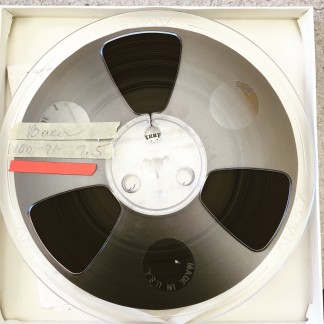
KUOM audio tape.
The University of Minnesota Archives has been deeply involved in documenting the history of radio broadcasting at the University of Minnesota since the spring of 2015, when we began a year-long processing project titled “Minnesota on the Air,” made possible by a grant from the Minnesota Arts and Cultural Heritage Fund of the Minnesota Clean Water, Land and Legacy amendment. To date, 127 boxes of print materials in the WLB/KUOM collection, in addition to materials in related collections, have been surveyed and cataloged.
Just last month, U Archives was again awarded a Legacy grant to digitize approximately 2,000 reel-to-reel audio tape recordings of radio broadcasts. Long silenced by remaining undocumented in the caverns of Elmer L. Andersen Library, the processed and digitized archival records of WLB/KUOM will soon restore an important voice in the history of radio broadcasting in the state of Minnesota.
History of radio broadcasting at the University
In 1912, Professor Franklin Springer began experimenting with wireless telegraphy – the sending and receiving of coded messages through electromagnetic waves – in the laboratory of the Department of Electrical Engineering. By 1914, the department offered coursework in “Radio Signaling Apparatus” and “Radio Transmission” and regularly conducted broadcasting experiments using the wireless equipment.
Cyril M. Jansky, Jr. joined the department as an instructor in 1920 and obtained an experimental license to operate a radio station on campus under the call letters of 9XI in March of that year. Engineering students – the station operators – broadcasted daily market and weather reports, musical programs, and play-by-plays of home football games.

The radio station inside the old Engineering Building displaying transmitting equipment, 1920.
On January 13, 1922, the University station was granted a full license to operate under the call letters WLB. In 1925, space was afforded for a radio studio in a newly constructed Electrical Engineering building which was outfitted with furniture and equipment in 1926.
In 1938, the University greatly expanded WLB programming. A new transmitter was purchased and a tower was erected on the University Recreation Field on the St. Paul campus. Broadcasting extended from under 10 hours per week to 30 hours per week. A full-time operator, Burton Paulu, was appointed to oversee the station. Paulu also developed “The Minnesota School of the Air,” a series of 15-minute programs broadcast for school children to listen-in from the classroom.
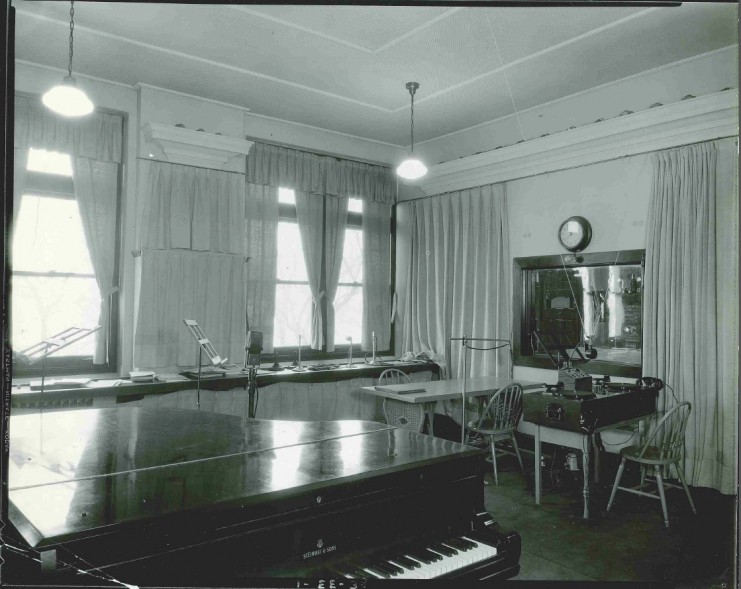
WLB Studio, 1938.
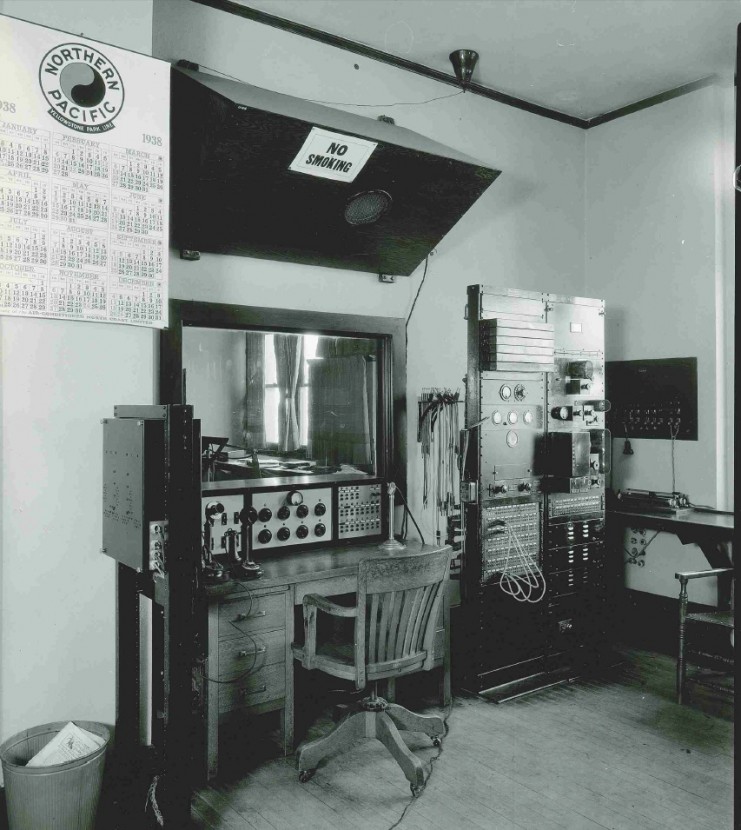
WLB Control Panel, 1938.
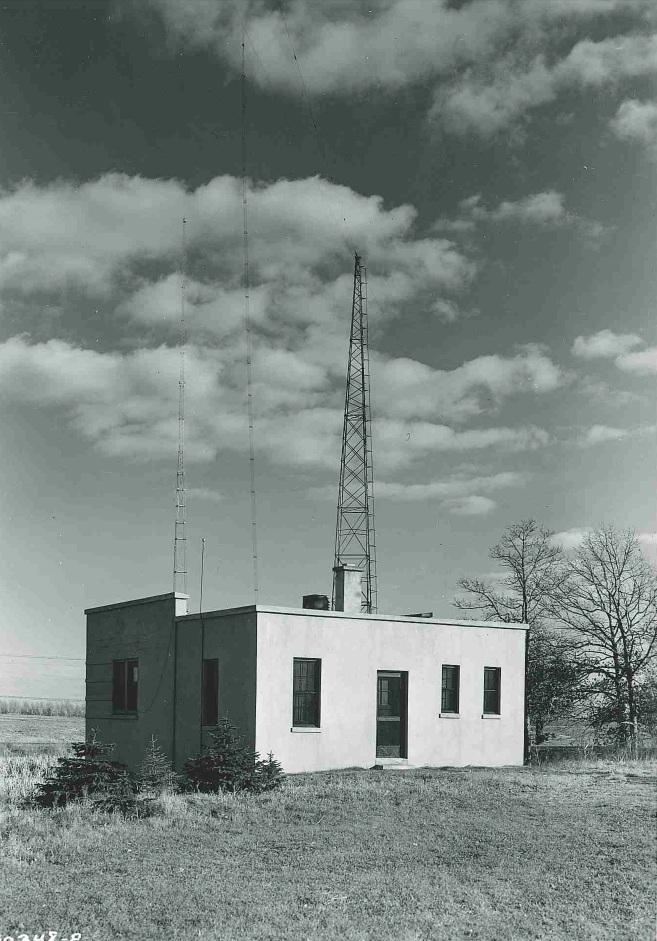
Station tower and maintenance house, 1938.
In 1945, to better identify the station with the University, the Federal Communications Commission approved a change in call letters from WLB to KUOM (K University of Minnesota). The station continued the popular School of the Air broadcasts, for which it relied on a cast of students, members of the University Radio Guild, a student organization, to play the parts in dramatizations. The station also relied heavily on members of the faculty to develop broadcasts based in the disciplines of their departments.
KUOM Program Bulletins from the 1950s
New studios were constructed for broadcasting in the basement of Eddy Hall and station operations moved to Eddy in the spring of 1939. The station operated out of Eddy from 1939 to 1974, when it moved to new facilities in the Rarig Center, the present operating location of Radio K.
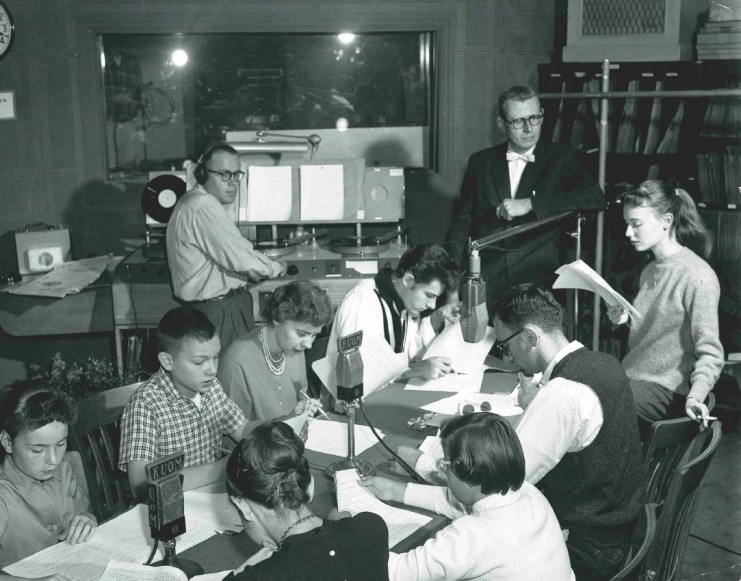
KUOM engineers and radio performers in the studio in 1959.
In 1993, KUOM merged with student-operated station WMMR (which broadcasted from Coffman Union) to form Radio K. In 2012, Radio K celebrated 100 years of radio broadcasting at the University of Minnesota, linking the station origin to the 1912 wireless telegraphy experiments conducted in the Department of Electrical Engineering.
More to come
Stay tuned as the University Archives shares more highlights of the history of WLB/KUOM, “The Voice of the University of Minnesota” as we continue our processing and digitization work in the coming months.
—Rebecca Toov is the project archivist for “Minnesota on the Air.” To learn more about the University of Minnesota Archives, please visit www.lib.umn.edu/uarchives.


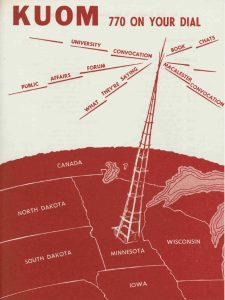



I was just reading a summary of important events in the history of the Woman’s Club of Minneapolis, and saw that Dr. William Henry Chamberlain, a prominent East Coast Historian, “managed to get over to WLB station” during the November 11, 1940 Blizzard, so that his talk could be heard “from the safety of members’ homes”. He was supposed to talk to over 500 members and guests that day at a luncheon, but with the blizzard, the city was paralyzed, and plan B was to get him to the University. I was unfamiliar with your history and appreciate the information on your site. MIght there be any pictures or audio of that speech available?
Thanks for the question! We checked into it and do not have a recording or photographs documenting the Dr. William Henry Chamberlain talk. We were able to look at the station log book for November 11, 1940 and did confirm there was a “Women’s Program” listed beginning at 10:45 am. If you have additional questions please feel free to contact us at uar@umn.edu. – University of Minnesota Archives